‘How would you survive?’: Desperation grows in Iraq water crisis
Parched communities, once displaced by the ravages of ISIL, can barely survive the decimation of their water supplies.
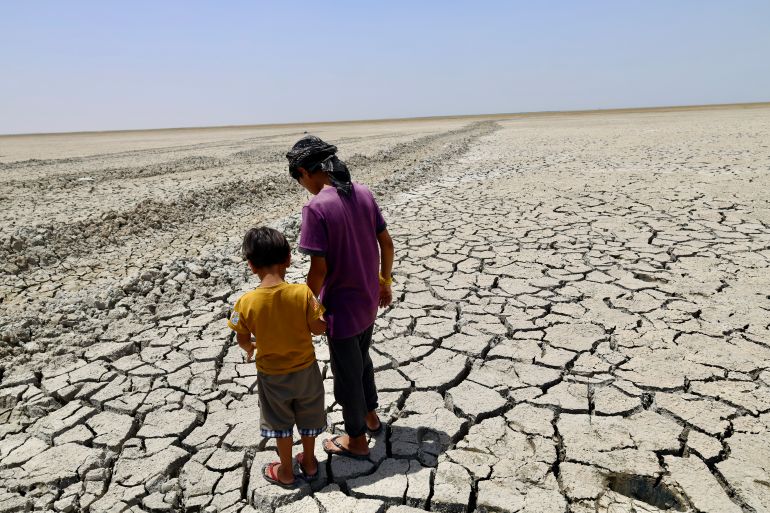
Ramadi, Iraq – The most precious resource in the villages of al-Ankour is water, and it’s gone. Many of the area’s 13,000 residents want to leave but don’t have the means to escape.
Habbaniyah Lake, once a sprawling body of water spanning 140sq km (55sq miles) with a capacity of 3.3 billion cubic metres (4.2 billion cubic yards), is rapidly shrinking as a devastating water crisis unfolds around it. The land is cracked, the sun stings and locals are struggling to cope.
Keep reading
list of 3 itemsPhotos: Iraq’s Christians fight to save ancient language
Qatari companies partner with Iraq on $9.5bn worth of projects
A trace of toxic waste wafts from the edge of the lake, the stench of putrid water hitting long before it can be seen. In some parts of the village, salt-encrusted ground irritates the nose, the burning sun increasing the residue.
“We have no water, no electricity, no air conditioning,” shouts Abdulraheem Ismail, 44, in front of his mud-brick home in al-Ankour, south of Ramadi, the capital of Anbar province in western Iraq, as the scorching midday heat reaches 40C (104F).
The villages worst impacted are on the south side of the lake, 40km (25 miles) from Ramadi.
An abandoned water purification tower, long out of use, looms to Ismail’s right.
The father of five has spent most of his life in al-Ankour, except for the period when the community fled to nearby displacement camps after the ISIL (ISIS) armed group captured the area. Although they returned in 2016, the current water crisis means most are now wondering where they can flee to this time.
About 30km (18.6 miles) farther east along the lake’s shore, a once popular resort town is also struggling as the water used to sustain thousands of people through fishing and tourism dries up.
Al Jazeera interviewed multiple residents who described the recent reduction in water as the most severe they have ever witnessed.
Nine months ago, due to the declining flow of the Euphrates River from neighbouring Syria, a barrage in Ramadi began redirecting the water away from the lake and towards Fallujah. Those who live around the lake were left with a dangerously reduced supply of water that formerly fed their villages.
Freshwater tankers sent by the local government two weeks ago are already dry. A well was dug recently in one village, but after reaching a depth of 86 metres (282 feet), it failed to strike water. Locals say they are reliant on plastic water bottles to sustain themselves.
Habbaniyah was built in the early 1980s as a water reservoir and tourist city during a short era of rapid development and financial prosperity in Iraq.
After the 2003 US-led invasion of Iraq, it fell into neglect and disorder, which was exacerbated in March 2015 when ISIL seized control of the area.
The Green Iraq Observatory, a local environmental organisation monitoring the situation, estimated in May that the 13,000 residents in the al-Ankour and al-Majar areas have been affected by shortages caused by redirection of water.
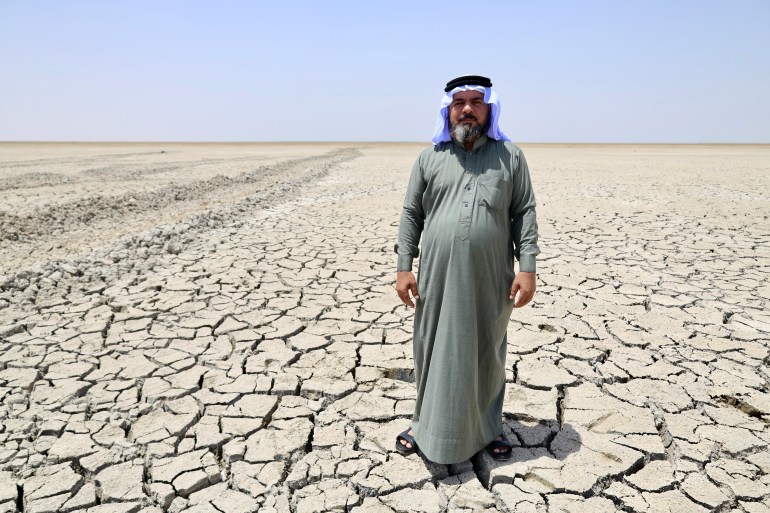
No work, no water, no escape
Firas Mohammed, 45, was also born in the village. “How would you survive here?” he asks, visibly angry. “We are stranded.” He blames Syria, Turkey (farther upstream) and Iran for the water shortages – but also local officials for mismanaging their water allocation.
“I pay 50,000 Iraqi dinars [$37] every week for bottled water for my family for drinking and cooking,” the former fisherman says.
“My sons travel to Ramadi to try to find manual labour to support us, but they can’t always find work. The situation is very bad.” He gestures at the dry, parched ground as he describes falling into debt to buy water. “All of this used to be the lake, at least 5 metres (16.5 feet) deep.”
Mohammed nods towards a trickle of lime green liquid nearby, shaking his head. “Take a sample from this water and test it. Even dogs avoid it.”
He lacks the means to leave.
“I don’t have the financial capacity to move to Ramadi,” Mohammed says. “If the government decided to move us to a camp with freshwater to cope with this crisis, we would even accept being moved to Ukraine.”
“Despite the horror and cruelty of war, it’s still better than living in drought and water scarcity,” he adds desperately.
Mou’ad Abel, 40, approaches on his bike, calling out to his two sons. “We returned to the village on March 8, 2016” after the area was liberated from ISIL, he says.
“In my youth, I worked here as a fisherman, but there are no fish anymore.”
His children, 13-year-old Rusool and six-year-old Waad, are quiet. “My only source of income has disappeared. The only other work is as a manual labourer in the city with a daily rate.”
Thirty families have already left the village, he says, and those who remain feel trapped. If he had enough money, he would leave without hesitation, he says.
Call for action
Activists like Nooraldeen Adil, 29; Amin Hamid, 32; Samim Salam, 28; and Zaid Mayouf, 32, are working to provide water to affected families and advocate for better solutions from local authorities.
Until recently, Hamid lived in one of the villages south of Habbaniyah. Adil, Salam and Mayouf grew up in Ramadi.
“We use our funds from voluntary donations to distribute water to them,” says Adil, who started the Peace Forum NGO in 2016. It works to support young people and foster dialogue in the community.
On the banks of the Euphrates, Ramadi is still overcoming the trauma of brutal fighting in the years following the US-led invasion and, later, Iraq’s five-month battle to liberate the city from ISIL control. After the group captured the area in 2015, tens of thousands of people fled, and entire sectors were razed to the ground.
“After the war, humanitarian work was really needed, and we noticed a lot of pollution in the river that wasn’t being addressed,” Salam explains.
“The ministries and government institutions need a push,” Adil adds. Seeking to provide a level of accountability that is lacking in Iraq, Mayouf posted a video on social media in May, showing families leaving al-Ankour.
“Recently, the crises are both humanitarian and environmental,” Mayouf says, estimating that more than 1,000 children are suffering from the lack of water in al-Ankour.
The area has just one small medical centre by the lake. It is open only in the mornings and is limited in what it offers to treat water-borne diseases, dehydration and lack of hygiene as opportunities to wash are constrained.
For the past six months, Salam has been compiling reports on the state of Anbar’s water pollution, tracking river levels and pollution in the ground and in water samples as well as the informal – in some cases, illegal – use of water, such as digging unauthorised wells. He shares his reports with local and national government bodies but has been frustrated with the lack of meaningful response.
“No action was taken to prepare them [local residents] for the situation,” Salam says. Recent samples of the river water, he adds, were six times more polluted than the average level.
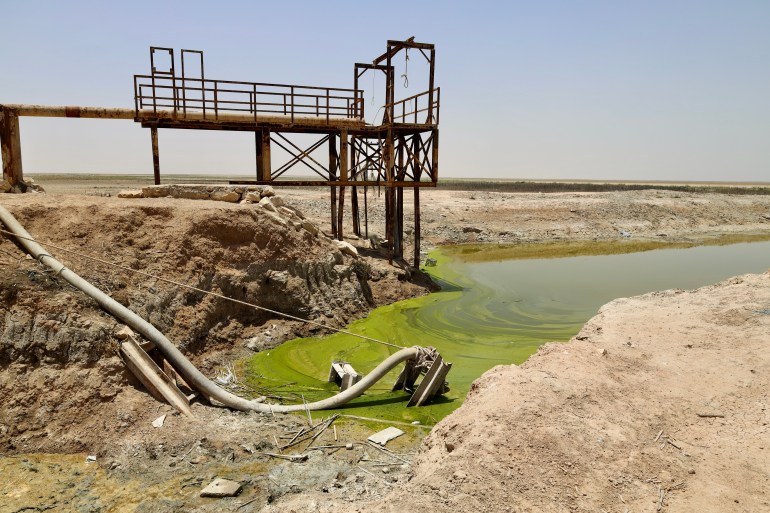
Water is politics
The crisis in Habbaniyah Lake is just one aspect of the country’s environmental threats.
The Ministry of Water Resources has warned that Iraq is facing its worst water shortage in a century with 7 million people experiencing reduced access to the resource.
According to the United Nations, 90 percent of the country’s rivers are polluted and Iraq will meet only 15 percent of its water demands by 2035.
Baghdad-based biologist and environmental activist Husam Sobhi has tracked the declining water levels of Iraq’s lakes through satellite images for the past three years.
“Habbaniyah has lost around 40 to 45 percent of its water since 2020,” he tells Al Jazeera by phone. “We need a strong negotiation strategy to improve Iraq’s access to water from neighbouring countries.”
In his air-conditioned office in Ramadi, Jamal Ouda Sameer, director of the water resources department in Anbar, is frank.
“If the situation continues like this, the lake will be empty soon,” he tells Al Jazeera, attributing the reduction in Habbaniyah to a combination of reduced water from the Euphrates from Syria and Turkey, a lack of rain and a heating climate, which he estimates has all occurred in the past four years.
It is a grim irony that in the 1980s, flooding would have been his department’s main problem. Parts of the Euphrates used to flow up to 4,000 cubic metres per second (141,000 cubic feet per second), Sameer says.
Khalid Shamal Mushab, a spokesperson for Iraq’s water ministry, says his ministry needs at least 500 cubic metres per second (17,700 cubic feet per second) of water released from Syria to feed the Euphrates. “But Iraq gets 200 cubic metres per second [7,000 cubic feet per second] in the best situations.”
Such is the serious decline in water levels that Sameer is happy to hear that the flow from Syria, measured around al-Qaim, is 250 cubic metres per second (8,800 cubic feet per second). Less than 100 cubic metres per second (3,500 cubic feet per second) is not uncommon and presents a serious threat to water access in Iraq as it flows further downstream.
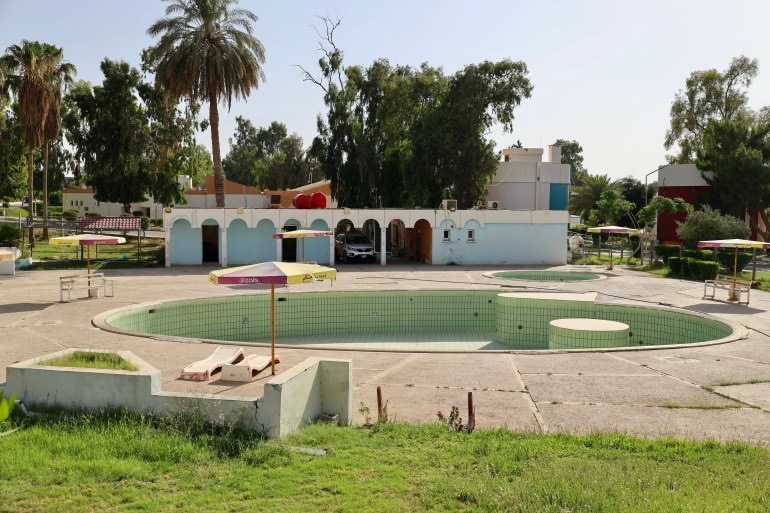
He acknowledges that at least 10,000 residents have been impacted in the villages surrounding the worst-affected southern area of the lake.
“The main purpose of the barrage is to open it when there is extra water – but this is unlikely now as the flow of water from the Euphrates in Syria is reduced.”
“We can open the water if the amount reaches 300 cubic metres per second [10,600 cubic feet per second], but the maximum we get now is around 200 cubic metres per second, and we need this water for others in Iraq to drink,” he says, estimating that shortages would affect half a million others if water continues to flow to Habbaniyah at the same rate as previous years.
“The population in the centre of the Anbar government is 500,000 residents. It’s impossible to deliver water for them if we open towards Habbaniyah.”
In Baghdad, the water ministry’s spokesperson tells Al Jazeera that his ministry is not responsible for the lack of drinkable water in villages.
“We can provide drinkable water to all Iraqis in the meantime, but municipalities and other service institutions have not worked or developed ways to deliver drinkable water to rural villages via an efficient pipe system.”
He also blames state institutions for water pollution as chemical, organic and medical waste is frequently disposed of directly into the river.
“It’s ridiculous that the health ministry reports about the spread of diseases among residents of the rural areas close to the river because of water scarcity,” he says. “According to our data, health institutions are the largest contributors to water pollution.”
The ministry has filed a lawsuit against multiple state institutions over the disposal of their waste but no actions have been taken yet, he says.
“In Qaim [farther upstream, closer to Syria], the water is good quality. By the time it has reached Ramadi, it’s bad. By the time it hits southern Iraq, it is toxic,” Sameer says. The issue is also political.
“All of Iraq’s lakes are in the west and north of Iraq,” he adds. “There is a water shortage in the middle and south, which must be supplied with this water.”
Peeling a thin lid from a small plastic cube of water, he shakes his head. “We import too much water. This is clean, but it won’t last forever.”
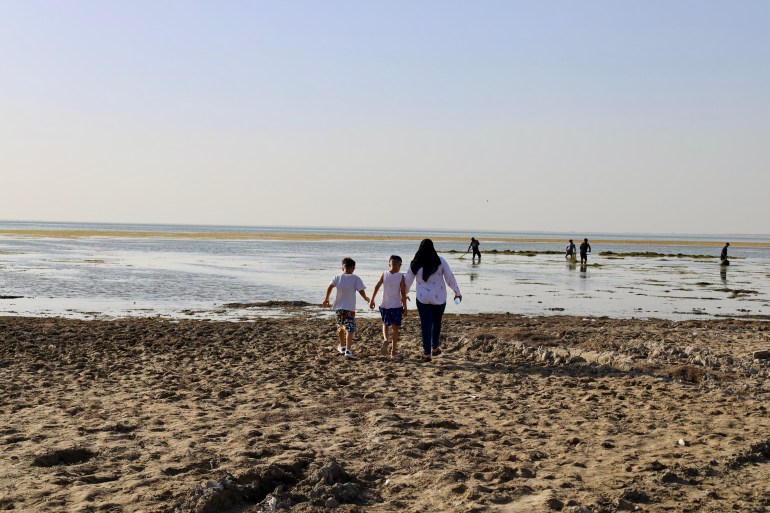
Meanwhile, at the entrance to a tourist village on the other side of Habbaniyah Lake between Ramadi and Fallujah – a once vibrant and glamorous attraction – a lonely security guard is bemused. “Why are you here? The water is already gone. You can’t even swim in it.”
Among the dilapidated pastel holiday homes, a family from Baghdad explores the dried-up shore. Noor Haddi, 35, reminisces about her childhood visits to the site and expresses shock at its current state.
Her two young sons venture towards the distant water, their legs sinking into the muddy ground.
“It used to be so beautiful,” she says, looking away.
“But two rivers [the Tigris and the Euphrates] have dried up. What hope should we have?”